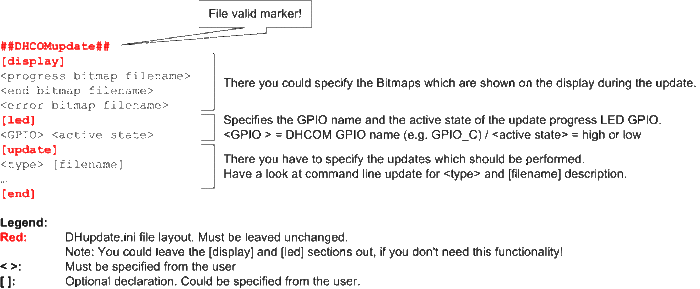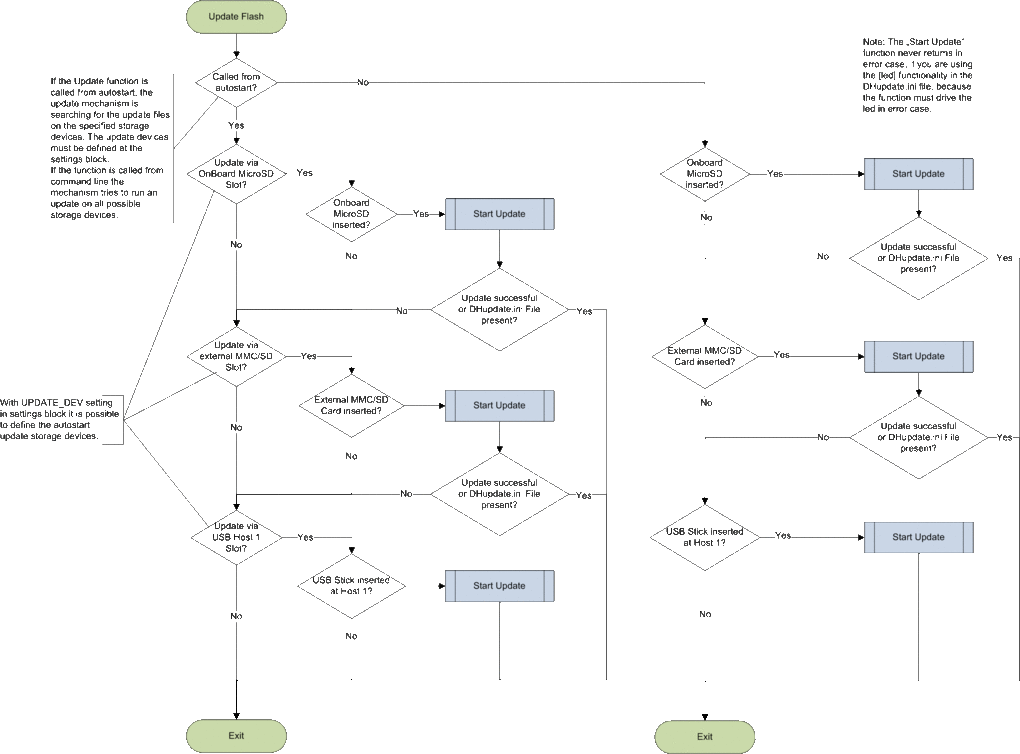DHCOM Update Mechanism: Difference between revisions
| Line 151: | Line 151: | ||
=== "Update Kernel" Handled Updates === | === "Update Kernel" Handled Updates === | ||
The following updates are done by the '''update kernel''': | The following updates are done by the '''update kernel''': | ||
:* bootloader (only in case of DHupdate.ini File update) | :* bootloader (only in case of DHupdate.ini File update) | ||
:* copy | :* copy | ||
Revision as of 12:36, 17 July 2015
The DHCOM Update Mechanism for the i.MX6 Module can be used to flash a complete system image or to replace on some parts (e.g. linux kernel) of the system. It is not necessary to have a running os. The only requirement is a running bootloader.
Overview
The following updates and commands are supported by the mechanism:
command description bootloader update the bootloader script bootloader executes the provided bootloader script e.g. to customize bootloader environment variables splash write a new *.bmp to display a bootloader splashscreen settings DHCOM bootloader settings copy copy a file e. g. uLinuxEnv.txt into the boot partition linux update the linux kernel binary e. g. zImage devicetree update the devicetree blob rootfs write a new rootfilesystem to the target finetuning run a provided script to do some finetuning on our installation (warning: experts only) eeprom update the display timings stored in the display adapter EEPROM reset reboot system after a successful update (warning: risk of a infinite update loop)
How does it work?
- The update mechanism has to be started with the bootloader command "update".
- The updates "bootloader", "script", and "eeprom" are processed by the bootloader. They can be started directly with "update <command> <imagefile>" for example "update bootloader u-boot_imx6dl-dhcom2_1G.imx"
- For the remaining updates you need a "update kernel". The "update kernel" is a file which contains the linux kernel binary (zImage), a busybox rootfilesystem with shell scripts (*.cpio), and a devicetree blob (*.dtb). This implies that the update kernel has to mach your board configuration like the bootloader, linux kernel, and devicetree concerning CPU Type, CPU Cores, RAM and NAND or eMMC memory.
- To control the processing of the updates you need to provide a "DHupdate.ini" file to the update kernel.
- For further Details see the following chapters.
Execution Modes
Automatic Mode
- To use the "automatic mode" the command "update auto" has to be called within the bootloader environment variable bootcmd. The functionality does search a DHupdate.ini file on the specified storage devices e. g. update devices. The update devices must be defined at the DHCOM settings block (Please have a look at DHCOM settings). The content of the DHupdate.ini file controls which updates have to be processed and which images have to be written to the storage device (eMMC or NAND) of the DHCOM computer on module system.
Commandline Mode
- Instruction: "update"
- The functionality tries to update the flash content via the DHupdate.ini file. In contrast to Automatically Update (which you can start with "update auto") the update mechanism is searching on every available storage device for the update files.
- Instruction: "update <command> [filename]"
- The functionality doesn't use the DHupdate.ini file. It allows only one update and the update mechanism is searching on every available storage device for the update files. With the <type> parameter you have to specify the update type.
- The following <command> parameters are possible from command line:
command description bootloader update the bootloader - Note: The ENV in Flash memory is created on the first start of u-boot. If you run a bootloader update and the ENV at the new bootloader has changed, the ENV in Flash memory remains unchanged with the bootloader update. But you could delete the ENV block in flash memory before the update, then u-boot will create the new default ENV at the next start after the bootloader update.
script bootloader executes the provided bootloader script e.g. to customize bootloader environment variables eeprom update the display timings stored in the display adapter EEPROM reset reboot system after a successful update. A reset can only be the last item in a DHupdate.ini file. - Warning: risk of a infinite update loop.
- The [filename] parameter could be used to specify a non default filename. The default filenames are:
command default filename bootloader default file name is u-boot.imx script default file name is script.bin eeprom default file name is eeprom.bin reset no file to specify
DHupdate.ini file
The DHupdate.ini file is a text file, which describes the user specified update mechanism.
Syntax
- The <type> parameter could be specified as follows:
<type> description bootloader update the bootloader script bootloader executes the provided bootloader script e.g. to customize bootloader environment variables splash write a new *.bmp to display a bootloader splashscreen settings DHCOM bootloader settings - Note: Please have a look at DHCOM settings.
refresh Set the new display settings for the current update process copy copy a file e. g. uLinuxEnv.txt into the boot partition linux update the linux kernel binary e. g. zImage devicetree update the devicetree blob rootfs Create or replace the linux root-filesystem which is stored in the Flash. The rootfs update has to be the last item (or second to last item if you insert the resetcommand) in the DHupdate.ini file. For further Details: DHCOM Update: Linux Root Filesystemfinetuning run a provided script to do some finetuning on our installation (warning: experts only) eeprom update the display timings stored in the display adapter EEPROM reset reboot system after a successful update - Note: If you update the DHCOM settings, it is possible to use the new settings for the update progress notifications on the display, by inserting the "refresh" command to the [update] section. The bootloader loads the new settings and calls the update kernel with the new parameters.
Example
##DHCOMupdate## [display] 800x480_progress.bmp 800x480_done.bmp 800x480_error.bmp [led] GPIO_E high [update] settings 13_DataImage_7inch_FG0700G3DSSW.bin refresh bootloader u-boot-nand.imx splash DH_800x480.bmp linux zImage devicetree dtbs/imx6dl-dheva01.dtb rootfs imx6_debian_rootfs.tar [end]
- For further DHupdate.ini File Examples please have a look at Download area iMX25 or Download area AM35x.
- Notes:
- It is necessary to use UNIX End Of Line conversion!!!
- The order of the bitmap-filenames in the section
displaytells the system when to display which bitmap.
.*If you use "refresh" command, please ensure that settings bin update is listed in DHupdate.ini file before "refresh" command.
Bootloader Handled Updates
The following updates are done by the bootloader:
- bootloader (only in case of command line update)
- refresh
- eeprom
- script
"Update Kernel" Handled Updates
The following updates are done by the update kernel:
- bootloader (only in case of DHupdate.ini File update)
- copy
- linux
- devicetree
- rootfs
- settings
- splash
- finetuning
Note: The [filename] parameter has to be defined if you use the update kernel.
Update progress LED description
The LED GPIO is activated as soon as update has started. This takes roughly 6 - 8 seconds. If the update was finished without an error, the LED GPIO is deactivated. If an error occurs during the update the LED GPIO begins blinking.
- LED error code:
- 1 LED blinking interval = DHupdate.ini File error (Wrong file content or no valid file found)
- 2 LED blinking interval = Necessary File for Update not found
- 3 LED blinking interval = Flash write or erase error
- 4 LED blinking interval = Wrong OS Image type (e.g. no WinCE *.gz or *.bin file)
- 5 LED blinking interval = Specified file not valid (e.g. linux *.env file)
- 6 LED blinking interval = Image file size is to large
- 7 LED blinking interval = Can't load update kernel / Internal ERROR

